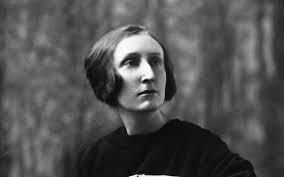Still Falls the Rain
Dame Edith Louisa Sitwell
Dame Edith Sitwell was a poet, critic and historian, and is regarded as one of the most important voices in 20th-century English poetry.
Edith Louisa Sitwell was born in Scarborough to a family whose ancestors included kings of France, the English Plantagenets, Robert Bruce and the Macbeths. It was Sitwell’s governess, Helen Rootham, however, who introduced her to poetry and specifically to the decadent 19th-century works of Verlaine, Rimbaud and Mallarmé. Encouraged by Rootham, Sitwell began to compose her own poems, and her first work was published in 1913 when she was 26. In the same year the two women, who were now friends, moved to London in pursuit of creative freedom.
Sitwell published her first poetry collection, The Mother and Other Poems, in 1915, soon attracting the ire of conservative critics with her experimental style. From about 1916 she began collaborating with her brothers Osbert and Sacheverell, and by the early 1920s the trio had emerged as something of a London literary cult. Their modernist journal, Wheels, provided an outlet for their radical literary and aesthetic ideas, but it was Edith’s 1923 reading of her poem series, Façade, at London's Aeolian Hall, that propelled them to fame.

The composer William Walton wrote the music to accompany her lyrics, giving them a variety of rhythms including the waltz, the paso doble and traditional sailor dances. Edith, meanwhile, delivered her verses through a Sengerphone – an instrument made of compressed grasses – from behind a transparent curtain, and with her back turned to the audience. It was so eccentric that some members of the audience thought they were being hoaxed. She became, overnight, the most talked-about poet in England.
Sitwell wrote prolifically, publishing over 20 volumes of poetry over the course of her career. In 1930 she turned to prose to write a biography of Alexander Pope, and followed it up with English Eccentrics (1933) and Victoria of England (1936), winning a reputation as a popular historian in the process.
The extent of her fame became clear when she visited the United States in 1950. In Hollywood, she was enthusiastically greeted by film stars such as Charles Chaplin, Greta Garbo, Merle Oberon and Marilyn Monroe. Esteemed for her poetry, she was also a captivating and flamboyant presence: tall and august, with an aquiline nose, she always wore a long, loose, flowing robe, a turban-like headdress and huge rings.
Her striking appearance was partly caused by Marfan syndrome – a genetic condition that can lead to a long-limbed appearance and weakness in the joints – and shortly after her return from Hollywood she started to use a wheelchair. Her pen, however, continued to flow, and she was made a dame of the British empire in 1954.
Dame Edith Sitwell in Hampstead
Sitwell spent three of her very last years in Flat 42 at Greenhill, Hampstead High Street, a large neo-Georgian apartment block of 1936 at the top of Rosslyn Hill. Her time at Greenhill was rather melancholy: when she arrived, in 1961, her health was failing, her reputation was beginning to be challenged, her finances were a cause of anxiety and her circle of friends was gradually passing away.
The flat was small – Sitwell described it as ‘just big enough for ghosts’ – and was shared with her nurse, Doris Farquhar. However, it was visited by many who trekked faithfully ‘to that Greenhill far away’. Sitwell’s triumphant 75th year, 1962, saw the publication of her biogaphy of Elizabeth I, The Queens and the Hive, her final collection of poetry, The Outcasts, and the reissue of Fanfare for Elizabeth (first published 1946).
In spring 1964 she moved to nearby 20 Keats Grove, and died soon after.
About the Cache
You’ll be looking for a sneaky micro geocache container that contains only a log strip for you to sign your find. So BYOP.
Please replace the cache at the same location so that the hint can always remain accurate.
Although you are in front of a private property, the cache respects the private space and is not within the block of flats or its limits.
About Hampstead_Twins
We are Hampstead locals and have recently discovered GeoCaching activity. As we are delighted with the place where we live and with the stories we find in every corner of this locality, we decided to share some curious facts about our neighbourhood and encourage GeoCaching activity in the region. We hope you enjoy.
If you found any errors, had any ideas for improvement while doing the route or even just want to talk with us and encourage more caches like this one, feel free to send us a message. We will respond to everyone as soon as possible. Let’s get in touch.
What’s Next?
Did you like what you saw here? If you haven't already, how about trying to find another cache in the heart of Hampstead? Look for ‘The Madman is a Dreamer Awake’ cache and have fun!